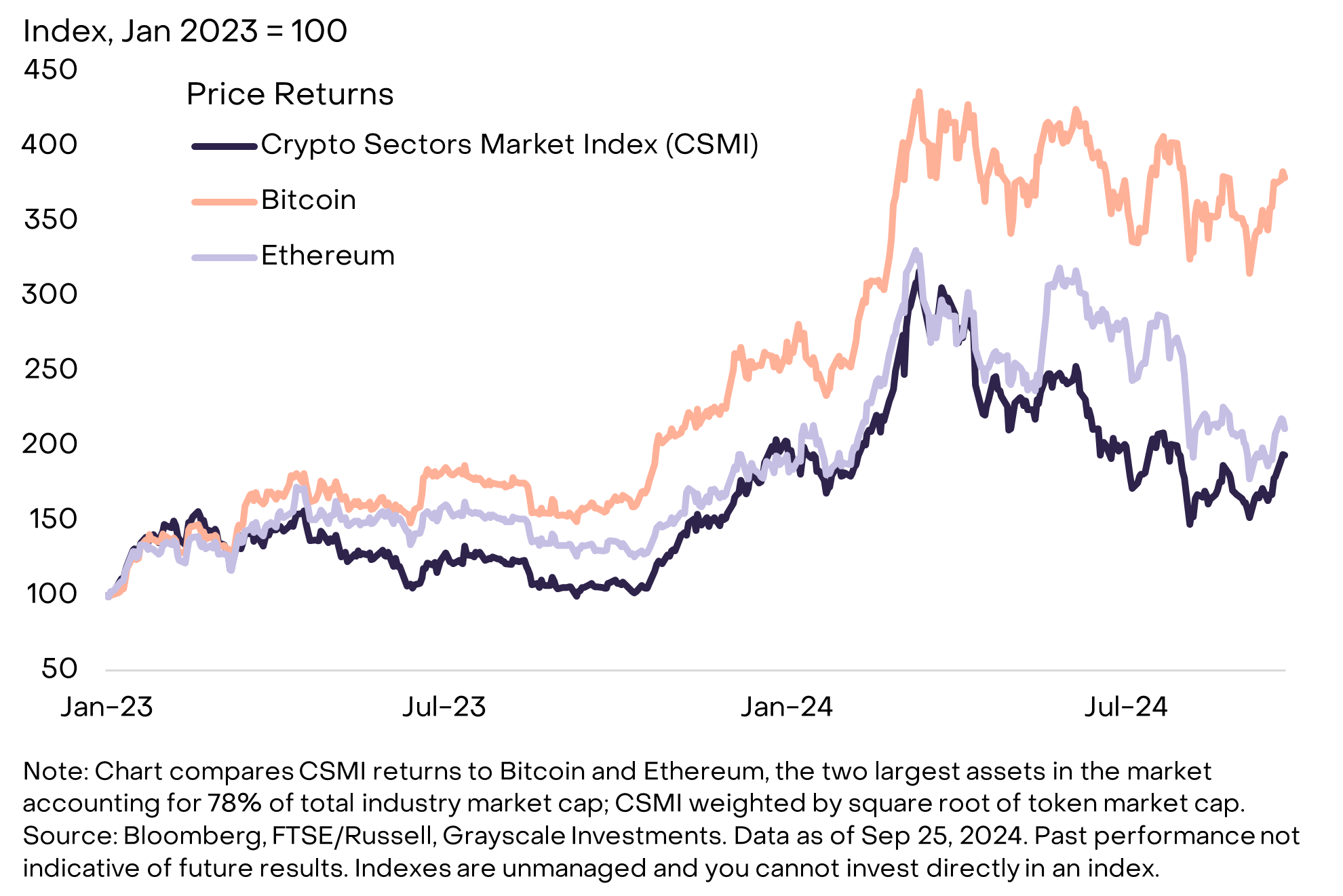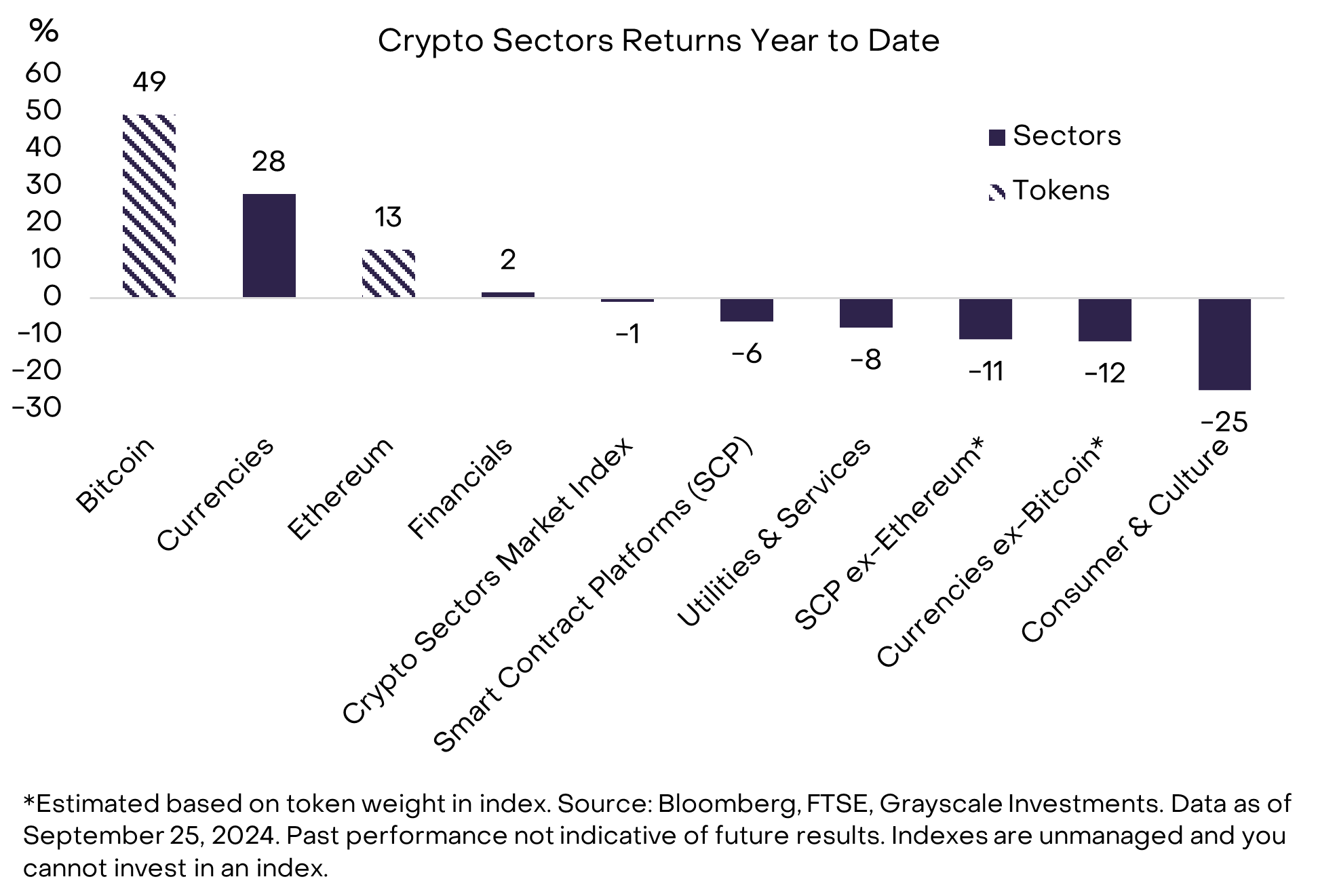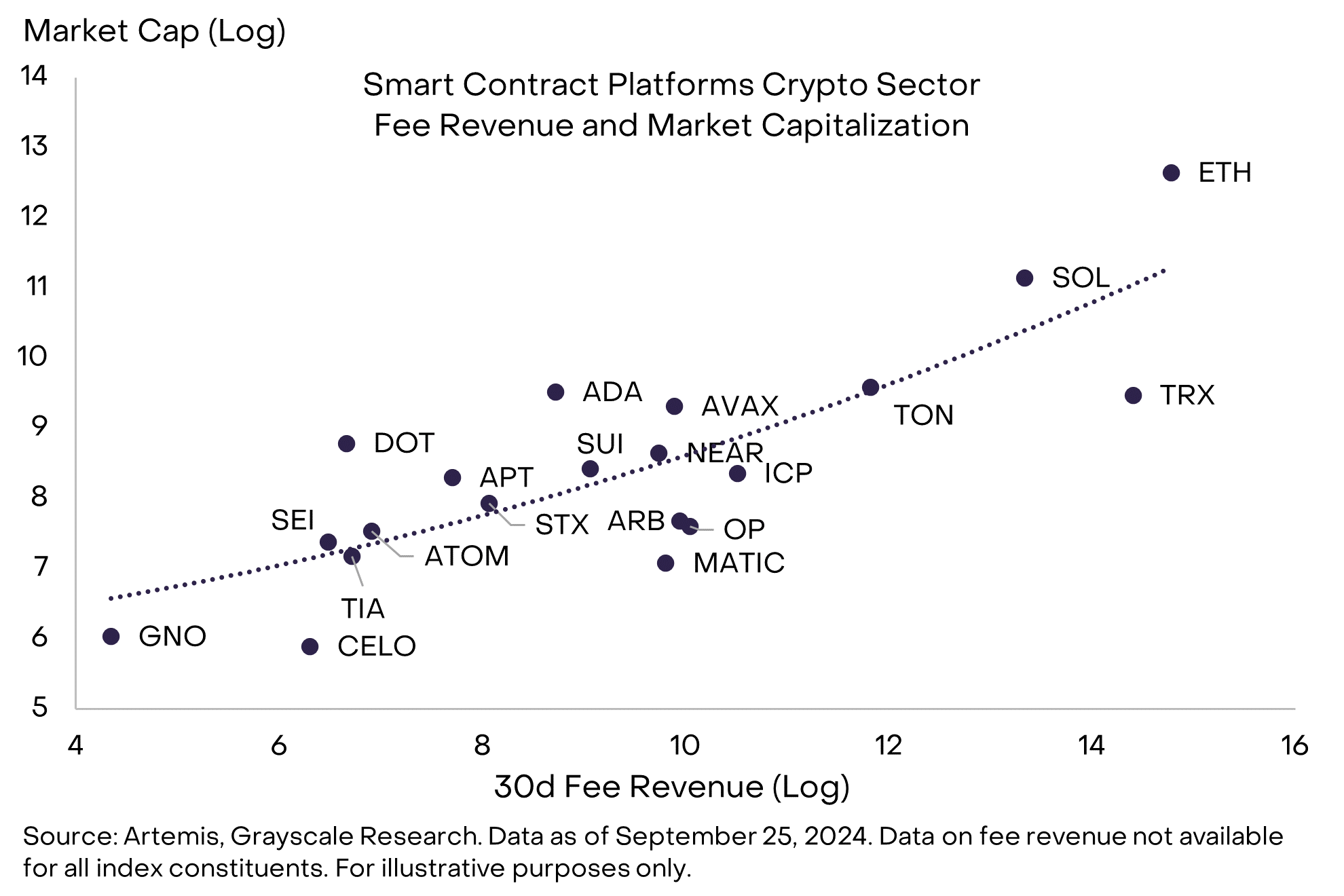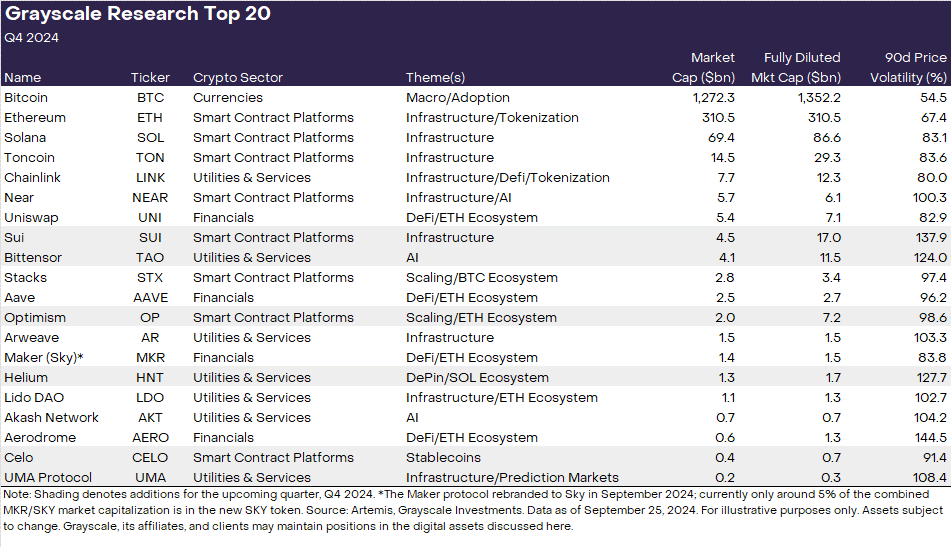作者:Grayscale
编译:深潮TechFlow
-
2024 年第三季度,加密市场横盘,依据 FTSE/Grayscale 加密行业指数系列进行评估。
-
今年对 FTSE/Grayscale 指数系列的变更突显了数字资产行业的新兴趋势,包括去中心化人工智能 (AI) 平台的兴起、对传统资产的代币化努力以及 memecoins 的受欢迎程度。
-
尽管以太坊今年以来的表现不及比特币,但仍优于智能合约平台加密行业指数。Grayscale 研究认为,尽管智能合约领域竞争激烈,以太坊仍有多种理由保持竞争力。
-
我们已更新 Grayscale 研究的前 20 位。前 20 位代表了一组多样化的资产,涵盖了加密行业,这些资产在未来一个季度具有高潜力。本季度新增的资产有 SUI、TAO、OP、HNT、CELO 和 UMA。
-
我们前 20 位名单中的所有资产都具有高波动性,视为高风险;美国选举也可能是加密市场面临的重大风险因素。
Grayscale 加密类别提供了一个全面的框架,用于理解可投资数字资产的领域及其与底层技术的关系。基于这个框架,同时与 FTSE Russell 合作,我们开发了 FTSE Grayscale 加密行业指数系列,以衡量和跟踪加密资产类别(图 1)。Grayscale 研究将加密行业指数纳入其对数字资产市场的持续研究中。

图1: 加密行业指数衡量资产类别的表现情况
加密行业框架旨在随着不断变化的数字资产市场动态更新,并在每个季度末进行再平衡。最新的季度再平衡过程在 9 月 20 日完成。自今年年初以来,指数再平衡带来了指数组成的重大变化,体现了新的交易所上市、资产流动性变化和市场表现。今年对加密行业指数的更新展示了数字资产行业的新兴主题,包括去中心化 AI 平台的崛起(例如,TAO)、对传统资产的代币化努力(例如,ONDO、OM 和 GFI)以及 memecoins 的受欢迎程度(例如,PEPE、WIF、FLOKI 和 BONK)。
从收益的角度来看,比特币和货币类加密类别在 2024 年表现优于其他市场领域(图 2),这可能反映了现货比特币交易所交易产品(ETPs)在美国市场的成功上市,以及有利的宏观环境(有关更多细节,可参考我们之前的季度报告《Grayscale 研究洞察:2024 年第三季度的加密行业》)。

图2: 比特币今年表现优于其他资产,但以太坊也不甘示弱
以太坊今年的表现逊色于比特币,上涨了 13%,但相较于大多数其他加密资产仍表现优异。例如,我们的加密行业市场指数(CSMI)——衡量整个资产类别的收益——今年下跌了约 1%。事实上,排除以太坊后,智能合约平台加密行业指数下跌了约 11%,因此它在其市场细分中表现显著优于其他资产。在我们加密行业框架内的所有资产中,以太坊年初至今的回报大约位于第 70-75 百分位。因此,尽管以太坊的涨幅低于比特币,但与其加密行业和更广泛的 CSMI 相比,今年表现依然不错。
聚焦智能合约平台
与主导货币加密行业的比特币不同,以太坊在智能合约平台中面临着激烈的竞争。今年,一些替代智能合约平台获得了广泛关注,包括 Solana、Toncoin、Tron 和 Near,以及新兴的 Sui。这些资产都在争夺费用收入,而一些替代智能合约平台提供的出色用户体验可能导致以太坊 Layer 1 的市场份额下降。
与此同时,以太坊在智能合约平台加密行业中具有多项竞争优势,这些优势巩固了其地位(图 3)。最重要的是,它仍然是该类别的领导者,拥有最多的应用程序、最多的开发者、最高的 30 天手续费收入,以及在智能合约中锁定的最高价值。在包括最大的以太坊 Layer 2 网络时,它的日活跃用户仅次于 Solana,位居第二。

图 3: 以太坊在智能合约平台的手续费收入方面是类别的领导者
随着公共区块链技术的不断发展,Grayscale Research 预计整个智能合约平台加密行业将在用户、交易和费用方面实现增长,这可能在一定程度上惠及该类别中的所有资产。由于以太坊是类别的领导者,很难想象在智能合约平台细分市场中出现持续增长的时期而不会惠及以太坊,部分原因在于其已有的网络效应。正因如此,尽管它面临着显著的竞争,我们认为以太坊在智能合约平台加密行业中仍然是一个引人注目的资产。
此外,以太坊受益于某些特定特性,这些特性可能在一段时间内抵御竞争对手。这些特性包括高网络可靠性(有限的停机时间)、高经济安全性、高度去中心化,以及在美国更清晰的监管状态。在以太坊生态系统内,也出现了一些令人鼓舞的采用情况,包括代币化、预测市场,以及像索尼这样的公司进行的开发。出于这些原因,Grayscale Research 继续认为以太坊具有非常引人注目的投资论点。
Grayscale Research 前 20 名资产
每个季度,Grayscale Research 团队分析数百种数字资产,以为 FTSE/Grayscale 加密行业系列指数的再平衡过程提供依据。在此过程中,Grayscale Research 会发布加密行业板块下资产前 20 名列表。前 20 名代表了一组多样化的资产,这些资产在我们看来具有高潜力(图 4)。我们的方法考虑了多种因素,包括网络增长/采用、即将到来的催化剂、基本面可持续性、代币估值、代币供应膨胀和潜在的尾部风险。
本季度,我们将六种新资产加入前 20 名资产:
-
Sui:一个高性能的第一层智能合约区块链,提供创新的应用(更多细节,请参见 Building Block: Sui)。
-
Bittensor:一个促进开放的全球 AI 系统开发的平台(更多细节,请参见 Building Block: Bittensor)。
-
Optimism:一个基于 optimistic rollups(一种扩展解决方案)的以太坊扩展解决方案。
-
Helium:一个运行在 Solana 上的去中心化的无线网络,是去中心化物理基础设施(DePin)领域的领军者。
-
Celo:一个移动优先的区块链项目,正在过渡到以太坊第二层网络,专注于稳定币和支付。
-
UMA Protocol:一个 optimistic 预言机,为 Polymarket 提供服务,它是一个领先的区块链预测市场(以及其他协议)。

图4:2024 年第四季度高潜力加密行业资产
新纳入的资产反映了 Grayscale Research 关注的若干加密市场主题。Sui 和 Optimism 都视为高性能基础设施的例子。Sui 是由一组前 Meta 工程师开发的第三代区块链。两个月前,Sui 进行了网络升级,使其交易速度提高了 80%,超越了 Solana,这导致了最近在该网络上采用量的增加。Optimism 是一个以太坊第二层,正在帮助扩展以太坊网络,并开发了一个构建扩展解决方案的框架,称为“超级链”(Superchain),该框架被 Coinbase 的第二层 BASE 和 Sam Altman 的 Worldcoin 构建的第二层使用。
Celo 和 UMA 都受益于独特的采用趋势:稳定币使用和预测市场。Celo 是一个专注于发展中国家稳定币和支付的区块链,并通过 Opera 浏览器的 MiniPay 应用在非洲获得了广泛关注。Celo 最近超越 Tron,成为每日地址上稳定币使用量最高的区块链,目前正在从独立区块链迁移到以太坊第二层,使用 Optimism 的超级链框架。UMA 是一个用于 Polymarket 的预言机网络,它是加密货币选举年突破性应用。UMA 在链上记录每个 Polymarket 事件合约结果,并促进对 Polymarket 结果争议的投票,确保在没有集中、任意或偏见干扰的情况下得到解决。
Helium 的加入反映了我们对行业领导者和具有可持续收入项目的偏好。Helium 是 DePIN(去中心化物理基础设施网络)类别的领导者,利用去中心化模型有效分配无线网络覆盖和连接资源,并奖励参与者维护基础设施。Helium 已扩展到超过 100 万个热点和 100,000 个移动用户,至今产生了超过 200 万美元的网络收入。
最后,尽管我们关注于去中心化 AI 主题已有一段时间,但 Bittensor 现在才被纳入我们的加密行业框架,这要归功于市场结构改善——具体包括更多可用的定价来源和更高的流动性。Bittensor 已成为加密和 AI 交汇处的重要参与者,试图利用经济激励创造一个全球去中心化 AI 创新平台,从而赢得了关注。
本季度我们已剔除以下项目出前 20 名:Render、Mantle、ThorChain、Pendle、Illuvium 和 Raydium。Grayscale Research 继续重视这些项目的价值,它们仍然是加密生态系统的重要部分。然而,我们认为修订后的前 20 名名单可能为下个季度提供更具吸引力的风险调整收益。
投资于加密资产类别涉及风险,其中一些风险是特有的,包括智能合约漏洞和监管不确定性。此外,我们前 20 名中的所有资产都具有高波动性,可能被视为高风险,并不适合所有投资者。最后,更广泛的宏观经济和金融市场发展可能会影响加密资产的估值,而美国在 11 月的选举被视为加密市场的重大风险事件。前总统特朗普明确支持数字资产行业,而副总统哈里斯最近表示,她的政府“将鼓励如 AI 和数字资产的创新技术,同时保护我们的消费者和投资者。”鉴于该资产类别面临的风险,对数字资产的任何投资都应在投资组合的背景下进行评估,并考虑投资者的财务目标。
免责声明:本文章仅代表作者个人观点,不代表本平台的立场和观点。本文章仅供信息分享,不构成对任何人的任何投资建议。用户与作者之间的任何争议,与本平台无关。如网页中刊载的文章或图片涉及侵权,请提供相关的权利证明和身份证明发送邮件到support@aicoin.com,本平台相关工作人员将会进行核查。




